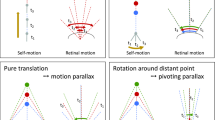Abstract
Self-movement of an organism through the environment is guided jointly by information provided by the vestibular system and by visual pathways that are specialized for detecting ‘optic flow’1,2. Motion of any object through space, including the self-motion of organisms, can be described with reference to six degrees of freedom: rotation about three orthogonal axes, and translation along these axes. Here we describe neurons in the pigeon brain that respond best to optic flow resulting from translation along one of the three orthogonal axes. We show that these translational optic flow neurons, like rotational optic flow neurons3,4,5, share a common spatial frame of reference with the semicircular canals of the vestibular system. The three axes to which these neurons respond best are the vertical axis and two horizontal axes orientated at 45° to either side of the body midline.




Similar content being viewed by others
References
Simpson, J. I. The accessory optic system. Annu. Rev. Neurosci. 7, 13–41 (1984).
Frost, B. J., Wylie, D. R. & Wang, Y.-C. in Perception and Motor Control in Birds (eds Green, P. & Davies, M.) 249–266 (Springer, Berlin, 1994).
Simpson, J. I., Graf, W. & Leonard, C. in Progress in Oculomotor Research (eds Fuchs, A. F. & Becker, W.) 475–484 (Elsevier, Amsterdam, 1981).
Graf, W., Simpson, J. I. & Leonard, C. S. Spatial organization of visual messages of the rabbit's cerebellar flocculus. II. Complex and simple spike responses of Purkinje cells. J. Neurophysiol. 60, 2091–2121 (1988).
Wylie, D. R. & Frost, B. J. Responses of pigeon vestibulocerebellar neurons to optokinetic stimulation: II. The 3-dimensional reference frame of rotation neurons in the flocculus. J. Neurophysiol. 70, 2647–2659 (1993).
Gibson, J. J. The visual perception of objective motion and subjective movement. Psychol. Rev. 61, 304–314 (1954).
Lee, D. N. & Aronson, E. Visual proprioceptive control of standing in human infants. Percept. Psychophys. 15, 529–532 (1974).
Owen, D. H. in Perception & Control of Self-Motion (eds Warren, R. & Fuchs, A. F.) 289–322 (Lawrence Erlbaum, Hillsdale, New Jersey, 1990).
Anderson, G. J. Perception of self-motion: psychophysical and computational approaches. Psychol. Bull. 99, 52–65 (1986).
Krapp, H. G. & Hengstenberg, R. Estimation of self-motion by optic flow processing in single visual interneurons. Nature 384, 463–466 (1996).
Duffy, C. J. & Wurtz, R. H. Sensitivity of MST neurons to optic flow stimuli. I. A continuum of response selectivity to large-field stimuli. J. Neurophysiol. 65, 1329–1345 (1991).
Bradley, D. C., Maxwell, M., Anderson, R. A. & Banks, M. S. Mechanisms of heading perception in primate visual cortex. Science 273, 1544–1547 (1996).
Wylie, D. R., Kripalani, T.-K. & Frost, B. J. Responses of pigeon vestibulocerebellar neurons to optokinetic stimulation: I. Functional organization of neurons discriminating between translational and rotational visual flow. J. Neurophysiol. 70, 2632–2646 (1993).
Wylie, D. R. & Frost, B. J. Binocular neurons in the nucleus of the basal optic root (nBOR) of the pigeon are selective for either translational or rotational visual flow. Vis. Neurosci. 5, 489–495 (1990).
Hess, B. J. & Dieringer, N. Spatial organization of linear vestibuloocular reflexes of the rat: responses during horizontal and vertical linear acceleration. J. Neurophysiol. 66, 1805–1818 (1991).
Macpherson, J. M. Strategies that simplify the control of quadrupedal stance. I. Forces at the ground. J. Neurophysiol. 60, 204–217 (1988).
Simpson, J. I. & Graf, W. in Adaptive Mechanisms in Gaze Control: Facts and Theories (eds Berthoz, A. & Melvill-Jones, G.) 3–16 (Elsevier, Amsterdam, 1985).
Soechting, J. F. & Flanders, M. Moving in three-dimensional space: frames of reference, vectors, and coordinate systems. Annu. Rev. Neurosci. 15, 167–191 (1992).
Knudsen, E. I., du Lac, S. & Esterly, S. D. Computational maps in the brain. Annu. Rev. Neurosci. 10, 41–65 (1987).
Jay, M. F. & Sparks, D. L. Auditory receptive fields in primate superior colliculus shift with changes in eye position. Nature 309, 345–347 (1984).
Masino, T. & Knudsen, E. I. Horizontal and vertical components of head movement are controlled by distinct neural circuits in the barn owl. Nature 345, 434–437 (1990).
Acknowledgements
We thank M. Dawson, D. Crewther and I. Curthoys for comments on this manuscript, and K. Lau and R. Glover for technical assistance. This research was supported by grants from the NSERC and AHFMR (to D.R.W.W.).
Author information
Authors and Affiliations
Corresponding author
Rights and permissions
About this article
Cite this article
Wylie, D., Bischof, W. & Frost, B. Common reference frame for neural coding of translational and rotational optic flow. Nature 392, 278–282 (1998). https://doi.org/10.1038/32648
Received:
Accepted:
Issue Date:
DOI: https://doi.org/10.1038/32648
- Springer Nature Limited
This article is cited by
-
From the eye to the wing: neural circuits for transforming optic flow into motor output in avian flight
Journal of Comparative Physiology A (2023)
-
Reduction of visual stimulus artifacts using a spherical tank for small, aquatic animals
Scientific Reports (2021)
-
The effect of monocular occlusion on hippocampal c-Fos expression in domestic chicks (Gallus gallus)
Scientific Reports (2020)
-
Selective processing of all rotational and translational optic flow directions in the zebrafish pretectum and tectum
BMC Biology (2019)
-
Localized direction selective responses in the dendrites of visual interneurons of the fly
BMC Biology (2010)





